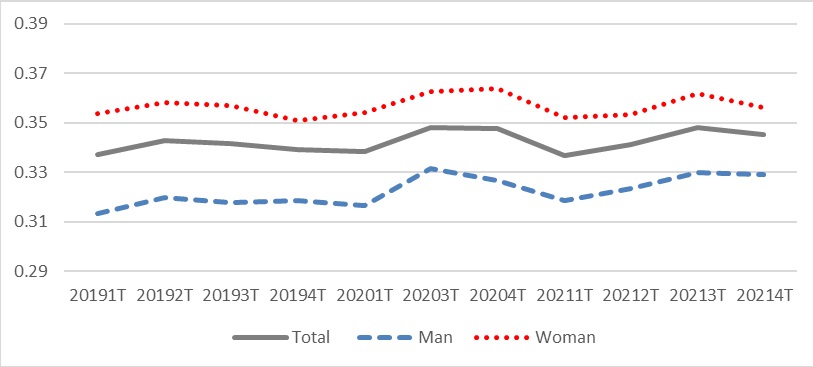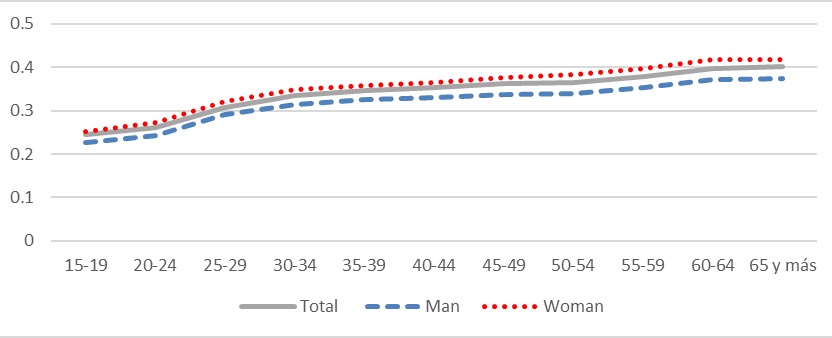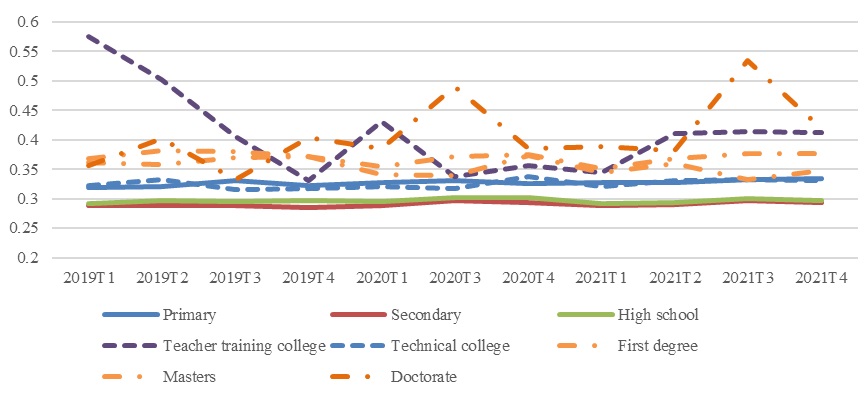Introduction
The COVID-19 pandemic had a significant impact on Mexico's economy and in particular on the labor market. As the country implemented containment measures, such as social distancing and the closure of certain industries, economic challenges emerged that unequally affected workers with higher education. This research problem focuses on analyzing income inequality among workers with higher education during the pandemic in Mexico.
The importance given to the study of inequality in employment and in the income received for work will help to promote a just society that provides opportunities for the development of employees.
It is a fact that gender inequality and other types of discrimination such as those of race, gender, social class, etc. have persisted for a long time as causes of a social structure whose institutions are based on cultural or social stereotypes, thereby creating inequality of opportunities.
The COVID-19 pandemic provoked social and economic changes, including changes in employment and the income of employees, and had repercussions in the third quarter of 2020 when the Economically Active Population fell to 51 million, amounting to a loss of 7.8 million jobs.
It should be noted that, according to a publication by the government’s labor observatory OLA (2023), there are economic activities in the Mexican labor market where more than half of the jobs are held by women, as in education, health, tourism, personal services and commerce, with 64.1%, 57.4%, 53.6% and 50.7 % respectively. These activities belong to the tertiary sector of the economy, which was one of the hardest hit during the pandemic, with activity in the third quarter of 2020 reduced by 6.5% from the same period in 2019, a situation that might in some way have affected the employment of women.
Further, in a previous study, Contreras et al. (2022) identified those whose employability was most affected after the pandemic as young people, and men. These findings were obtained after studying employees according to their educational level, and in this context, the most badly affected were women who had only basic studies, whereas for those with higher levels of education, employment increased by 4%.
This leads us to the objective of the present study which is to estimate how the pandemic affected employees with higher education, identifying possible inequality according to sex, age group and professional training, as well as measuring the impact on income, differentiated by sex and professional training. And as specific objectives: estimate inequality around the sociodemographic characteristics and level of education of the EAP in the period of analysis; identify if there were changes in inequality given the sociodemographic characteristics and level of education of the EAP, in the immediate period, first quarter of 2020, quarter after the pandemic, third and fourth quarters of 2020 and first quarter of 2021; detect income inequality by areas of professional training and measure the impact of income inequality during the pandemic on workers according to the area of professional training.
Data for the analysis are taken from the national occupation and employment survey, Encuesta Nacional de Ocupación y Empleo (ENOE), for the years from 2019 to 2021. Although the data of greatest interest in the study comes from 2020 when the pandemic began, this survey was used because the ENOE is the main source of information on the labor market in Mexico since it offers data on the workforce, occupation, labor informality, underemployment and unemployment. The ENOE is the country's largest ongoing statistical project, providing national figures for each of the 32 states and 39 cities. Data from 2019 was used as a comparative reference.
Prior to analysis, using the technique of MAR (missing at random), we sought to correct the deficiency of data in the data base caused by the omission of information on the variable income, which those questioned tend not to provide, and then, to estimate the inequality, we used the GINI index (GI), and finally, to measure the impact on income we used two Mincer equations, one for men and one for women, having chosen the EAP for employees with higher education qualifications.
The results are intended to identify the groups that tend to be the most vulnerable, with the aim of finding the causes of economic inequality in the face of contingencies, which in this case concerned health, and may provide information for making public policy proposals that would be more effective in reducing inequality.
The present work continues with a second section, containing a review of the literature; in the third part the objectives and hypothesis of the study are presented; in the fourth an account is given of the methodology used; in the fifth, the main results are presented; and finally, the paper ends with a discussion and the conclusions.
Review of the Literature
To investigate the central issue of this study, which is the income inequality of workers with higher education during the pandemic, we consider human capital theory, which suggests that investment in education and training can increase productivity and, therefore, workers' income. Furthermore, this theory proposes sociodemographic characteristics, such as educational level, work experience, and skills, as key components of human capital.
In this sense, Becker 2009 proposes that the economic agent has rational behavior, invests for himself and that the investment is made based on a maximizing calculation subject to a budget constraint in a perfectly competitive market. His approach is based on the idea that people who invest in their education and training do so like companies invest in machinery or equipment.
In this order of ideas, it is recognized that the COVID-19 pandemic provoked big social and economic changes, which the labor market was not able to escape. A number of studies on the subject have pointed out that so far there is no evidence for permanent changes to conditions of employment. In their study, Campos-Vázquez et al. (2020) analyzed texts on the skills and personal characteristics required for jobs and the wages offered, and found that there was a reduction in the number of jobs offered but not in the demand for employment; the structure of the demand for labor changed temporarily: with a greater demand in April for low wage labor, for occupations requiring a low level of education and for unskilled workers, but from May to July demand rose again to the same levels as before the pandemic. During this period there was no increase in working from home, and the abilities and personal characteristics required did not change during the pandemic.
With regard to per capita income, CONEVAL (2020a), reported a reduction of 12.33% in real labor income in Mexico between the third and the first quarters of 2020, and of 4.8% between the first quarters of the years 2020 and 2021. For his part, Monroy (2021), points out that the greatest reduction in income was for the lowest income population and that this caused an increase in income inequality.
Following the same line of thought, Cruz, Fajardo, Hernández and Fuertes (2021), studied the tendency of inequality in employment income in countries of Latin America and the Caribbean, through a prospective analysis of how the COVID-19 pandemic would affect the incomes of employees, and its repercussions on poverty and inequality. One of the conclusions they came to is that the incidence of poverty might increase by 25% to 33%, while income distribution would worsen, with the Gini coefficient rising from 0.473 to 0.498 for average incomes. The most affected were those people who were already in situations of vulnerability before the pandemic, especially informal, independent or unpaid workers and those working in small businesses or in sectors that found themselves restricted by lockdown measures, for example in commerce, services and construction.
The impact of social isolation was analyzed by Beccaria and Maurizio (2020), who observed that the economic activities considered essential and therefore not included in the restrictions, amounted to only a third of private employment and roughly a quarter of the total. In certain productive sectors the impact was greater: with around 75% of industrial employment and approximately half of the employment in commerce being subjected to the restrictions.
In this context, those least affected were workers in activities deemed essential, and salaried employees of big companies, working in activities that were not exempted from the restrictions. However, some of these workers, such as the self-employed in specific activities and/or particular zones, suffered a reduction in their income, as sales were reduced with the restrictions on consumers’ movements and behavior in a situation of great uncertainty.
In relation to which, in the context of Latin America, Lobato (2020), analyzed gender inequalities in the light of the pandemic in Argentina and determined what the socio-economic effects that impacted the world of work were, in terms of two variables: first, in relation to the classification of the work as being essential, and secondly, in respect of the nature of the work and the possibilities it had for adaptation to digital forms of provision.
With regard to the first variable, it was observed that many of the activities considered essential, both in Argentina and in other countries of the region and the world, are feminized jobs. One of these sectors is work in private homes (of which 97% is done by women), and another is care for other people (with about 30% of the tasks being undertaken by women). These jobs placed them in a situation where they were more likely to be exposed to the illness. The health sector, considered essential, was one of the pillars of fighting against the pandemic. Both in Argentina and elsewhere, 70% of this work is performed by women. These female workers faced long days at work and were exposed to the illness to a greater extent, which had an effect on their income.
As for the second variable, because women are concentrated in the service sector in general, they adapted to a greater extent than men did to working from home and the digitalizing of their labor, and as a result in this sector incomes were reduced by less.
In the context of Mexico, Salas, Quintana, Mendoza and Valdivia (2020), conducted a prospective study based on an analysis of income and employment between 2012 and 2019 compared to the first quarter of 2020. They established in their study that the effects on income and employment in Mexico were not homogeneous, the most affected zones being the states of the center of the country and on the northern border, due to the presence of manufacturing industry and shutdowns of the economy between Mexico and the United States, and also the states that depend on tourism such as Baja California Sur, Guerrero and Quintana Roo.
The sectors earning salaries most affected during the pandemic were: professionals and technical staff; auxiliary staff in administrative activities; shop assistants or sales representatives; those working in personal services; those providing domestic services; workers in agriculture, livestock, forestry, hunting and fishing; artesans; domestic laborers (contracted); industrial machine operators, those working on an assembly line, chauffeurs and transport vehicle drivers. The self-employed sectors most affected were: salesmen and women, personal service providers, domestic service providers; workers in agriculture, livestock, forestry, hunting and fishing; artesans and street sellers.
In the social order, according to figures from the International Labor Organization (OIT, 2021), the situation of male and female workers was reflected in the problems faced by companies that came with the interruption or a tight restriction of their activities. The situation was said to be variable in terms of sectors, but it was evident that the most affected were small and medium sized enterprises, because of their limited reserves, and they were also the least resilient. The results of the study showed that 70% of SMEs had serious financial difficulties, amounting to 50% more than the biggest companies (OIT, 2021).
The success of higher education as a mechanism for reducing inequality is mediated by various systemic processes. Even though in Latin America the university has had a developmentalist approach that has made it a transforming agent of social realities, this function needs to be considered a key driver of processes of development, especially in the field of public policies. There are still barriers in Mexico against the expression of this virtuous relation between the university and society, for which there are many reasons.
In relation to this, the authors mention that the International Labor Conference, ILC (CTI in Spanish), plays an important part in creating conditions in which the abilities generated in the universities can be expressed in society.
Objectives and Hypthesis
Following what has been reported by different authors in previous studies, the objective is to estimate how the pandemic affected inequality in employability, in the period from the first quarter of 2020 to the first quarter of 2021.
The specific objectives are:
To identify the socio-demographic aspects of the inequality, such as sex and age group and level of education.
To detect inequality in employment according to areas of professional training.
To measure the impact of inequality on the incomes of employees according to areas of professional training.
Within the framework of this research, several hypotheses were proposed that served as the basis for the study. These hypotheses represent fundamental assumptions about the relationships between variables and phenomena, and have been formulated considering the available information and the logic underlying our research problem.
H0: Socio-demographic characteristics impinge on employment.
H0: Level of education and training impinge on employment.
H0: There is a difference between the incomes of male and female workers with further education.
The proposed hypotheses consider the theory of human capital, especially in the aspects indicated by Becker (2009) regarding:
Returns on investment in human capital, which indicate that investments in human capital generate greater returns and income throughout working life, Therefore, the greater the investment in education and training, the greater the income there will be in the future.
Discrimination and prejudice can affect human capital and people's income in a competitive labor market, but this decreases as companies seek to maximize their profits.
Methodology
Data
The data used in this study are taken from the national survey into work and employment (la Encuesta Nacional de Ocupación y Empleo, ENOE), for the years 2019 to 2021. The survey was conducted by the National Institute of Geography and Statistics, INEGI (Instituto Nacional de Geografía y Estadística). The aim of ENOE is to provide figures for the occupations and employment of the economically active population (EAP).
The features of ENOE make it possible to disaggregate information according to different lines of interest, as in the present case when a selection was made from the EAP of interviewees with at least a first degree who said they were occupied and received payment. The size of the sample after selecting the information required for this study continues to be representative of the whole population as over 123,000 households were interviewed for each quarter.
To put the study in context, the analysis was applied to information from the quarters available of the years 2019 to 2021. Subsequently, to emphasize the effects of the pandemic, before, during and after the event, the quarters available for 2020 and the first quarter of 2021 were analyzed for workers with further education.
It should be mentioned that it is normal to use the figures for the second quarter of the year, because it is considered more stable in terms of the employment situation of the EAP, however, for this study, with the aim of detecting any possible differences between quarters as a result of the pandemic, all three quarters were used for every year analyzed, excluding the second quarter of 2020, because during the lockdown the survey for this quarter was changed to consultation by telephone (Telephone Survey of Occupation and Employment, Encuesta Telefónica de Ocupación y Empleo, ETOE), which means that neither the interviews nor the samples are exactly comparable with the data from the other quarters and the traditional ENOE.
The variables taken into account are sex, years of education, income for the job, age in five-year groups for members of the population aged 15 or more, level of studies (teacher training, technical college, first degree (bachelor’s), masters and doctorate) and the field of academic study, as shown in Table 1:
Table 1 Variable of the field of academic training received.
| Sciences of Education | Physics, Chemistry and Earth Sciences |
| Teacher training | Mathematics and Statistics |
| Arts | Computer Siences |
| Humanities | Industrial engineering, mechanics, electronics and technology |
| Social sciences and studies of behavior | Manufacturing and processes |
| Sciences of information | Architecture and construction |
| Business and administration | Agronomy, forestry and fishing |
| Law | Veterinary science |
| Natural sciences | Health |
Techniques for the analysis
Attribution of missing at random (MAR) data
Taking into account the tendency originally demonstrated by Rodríguez-Oreggia and Videla (2015), and corroborated in the present study, for the number of people interviewed in the ENOE who do not provide information in their income, we use data for the variable income according to occupation, with the aim of minimizing the bias that comes with attributing the answer to them. The methodology considered is the hot-deck proposed by Campos (2013), for the attribution of missing salaries randomly (MAR), and this method of attribution as defined by Little and Rubin (2002), is applied when there is a correspondence between the probability of not answering the question - which in this case refers to the salary - and the explicative variables of the same, but the categories of its vector appear randomly.
The attribution involves assigning an estimated value to the variables with missing data. To use the MAR, first the tendency for the individuals interviewed to provide no information on their wages is verified. Figure 1 sums up the tendency, where it can be seen that from the figures provided by the ENOE for the third quarters of 2019 to 2021, the tendency not to report income has increased by 1.08%, a situation that demonstrates that there may be variables corresponding to the salary. Therefore, on the basis of the difference over time in the mean values of the variables chosen for explaining income, which for this case were sex, age group of ten years, level of studies, civil state and position at work, it should be determined whether the probability of reporting income or not is connected to the characteristics of the individuals interviewed.

Source: Figures for the quarterly PEA obtained from ENOE (2019-2021).
Figure 1 Percentage of workers who do report any income
Table 2 shows the results of the mean differences, with P < 0.000 for all cases, so there are differences between those interviewed who report and those who do not report their incomes, that is to say, the probability of not reporting income is connected to the explicative variables for why the missing salaries are random.
Table 2 Mean differences, among those interviewed reporting their income or not.
| Mean | Statistical t | Sig. | ||
| Not reported | Reported | |||
| n= 605666 | n= 1278951 | |||
| Sex | 1.4 | 1.41 | -8.048 | 0 |
| Age | 5.43 | 5.38 | 12.632 | 0 |
| Level of education | 4.62 | 4.1 | 171.667 | 0 |
We can also state that men, older people, those with a higher level of education, single people and the self-employed are more likely not to report their salary. Given the evidence that shows both the graph of the tendency and the mean differences, it was established that the ENOE has MAR characteristics for the variable income, so we went on to attribute the figures by the hot-deck method.
Following the attribution of data in the data base used, we proceeded through the Gini index to determine income inequality by identifying the socio-demographic characteristics and those of the academic education of the employees who were most affected in their incomes as a consequence of the pandemic.
Gini index
The Gini Index (GI) is useful for calculating income inequalities, using the values from 0 to 1, where 0 reflects perfect equality and 1 complete inequality. The calculation is made with the following formula:
Where:
P = cumulative percentage of the population
Q = cumulative percentage of income
With the help of the GI in this study we hope to detect how the pandemic affected the income of human capital in Mexico IG, identifying its impact by sex, age group, level of studies and professional training.
Mincer income equation
The rate of return on education known as the Mincer (1974) income equation, consists of estimating, by ordinary least squares (OLS) using as a dependent variable the natural logarithm of incomes and as independent variables the percentage increase in income per year of schooling, the work experience known as potential experience. Potential experience is included in the model in linear and quadratic form, as there is a positive linear relation between income and experience, and also because with the increased age and experience of people, their income increases at a declining rate which is due to the obsolescence and exhaustion that people show as age increases.
The income equation is expressed thus:
Where:
ln Yi = the natural logarithm of the individual’s monthly income i, where i = 1 ,..., n.
Aes = years of schooling;
Exp = potential experience ( Age- aes - 6);
Exp2 = potential experience squared;
ui = term for stochastic error for each i-th individual.
One of the objectives of this study apart from observing inequality before, during and after the pandemic, is to learn how it affected income for men and for women, and in the case of women employees also differentiating them through the area of their professional training; for this reason various estimates will be made of the income equation: by sex, and by each of the specific fields in the classifications by INEGI (2011).
Results
Descriptive analysis
Firstly, it was determined that 40.5% of those interviewed were women, and the level of education overall was mainly teacher training, technical college, first degree, masters and doctorate, with a distribution for men of 0.1%, 2.5%, 22.2%, 1.7% y 0.3% respectively, and for women, of 0.2%, 5.4%, 27.3%, 2.5% y 0.3% respectively. Average income and percentage of the total for men and for women are itemized in Table 3.
Table 3 Average income/ percentage of the total: by level of education and professional area
| Men | Women | |||
| Income ($) | Share of total (%) | Income ($) | Share of total (%) | |
| Primary | 5,536.15 | 18.80 | 3,643.10 | 15.50 |
| Secondary | 6,387.88 | 29.90 | 4,338.08 | 26.70 |
| High school | 6,761.97 | 24.40 | 4,997.28 | 22.00 |
| Teacher training college | 7,492.21 | 0.10 | 6,338.25 | 0.20 |
| Technical college | 8,014.26 | 2.50 | 5,726.04 | 5.40 |
| First degree | 8,537.27 | 22.20 | 7,256.20 | 27.30 |
| Masters | 13,520.00 | 1.70 | 11,360.07 | 2.50 |
| Doctorate | 14,978.75 | 0.30 | 13,428.81 | 0.30 |
| Education sciences | 10,068.18 | 2.60 | 8,011.27 | 6.90 |
| Training as a teacher | 8,663.57 | 4.30 | 7,641.04 | 10.60 |
| Arts | 7,155.29 | 2.10 | 6,499.04 | 2.50 |
| Humanities | 7,882.30 | 1.10 | 7,360.17 | 1.50 |
| Social sciences and behavioral studies | 8,506.74 | 3.40 | 7,049.46 | 8.90 |
| Information technology sciences | 8,252.68 | 1.60 | 6,863.18 | 2.10 |
| Business and administration | 8,845.79 | 25.10 | 7,257.31 | 30.20 |
| Law | 8,637.57 | 9.50 | 7,603.28 | 8.20 |
| Natural sciences | 8,762.76 | 1.20 | 7,727.51 | 1.60 |
| Physics, chemistry and Earth sciences | 10,120.94 | 0.60 | 8,381.28 | 0.40 |
| Mathematics and statistics | 9,441.88 | 0.30 | 7,819.71 | 0.20 |
| Computer sciences | 8,513.96 | 3.90 | 6,759.06 | 2.70 |
| Industrial engineering, mechanics, electronics and technology | 8,751.43 | 25.30 | 7,421.14 | 6.20 |
| Manufacturing and processes | 9,946.82 | 1.30 | 6,789.09 | 0.80 |
| Architecture and construction | 9,192.85 | 6.90 | 7,777.97 | 1.90 |
| Agronomy, forestry and fishing | 8,768.97 | 2.70 | 7,012.46 | 0.50 |
| Veterinary science | 8,222.53 | 1.10 | 6,554.79 | 0.40 |
| Health | 9,475.44 | 6.80 | 7,725.50 | 14.30 |
Figures 2, 3 and 4 below show the estimated inequalities for the EAP with the quarterly GI, differentiated by sex, age group, level of studies and professional training, for those among the interviewed with first degrees, masters or a doctorate. Here the differences in pay for men and for women can be observed, that amount to a constant of approximately 3%, except during the period of lockdowns, when a slight narrowing of 1.2% is seen; with regard to the ages of those interviewed, the gap between men and women increases with age and it can be seen that for those in the age groups from 15 to 39, inequality is 3%, for those aged between 40 and 54 it is 4% and for those aged 55 or more, it is 5%. During the period analyzed it can be seen that for the EAP as a whole and according to sex, the highest rate of inequality was in the third and fourth quarters of 2020, at 34, 33 and 36% respectively.
The aim of this study was to detect changes in income according to the level of schooling of employees, during and after the pandemic, emphasizing workers with qualifications from further education.
Next, the analysis considers the level of education, first in a general way including all levels of study: then according to the three groups of basic level (primary and secondary), higher technical level at university (teacher training and technical college), and further education (first degree, masters and doctorate), including those with an advanced technical and a higher level qualification, and finally we analyze inequality according to the field of academic education.
Figure 4 gives a graphic representation of the income gaps for different levels of study, that applies to the quarters analyzed. We can see from this that workers with basic studies kept the same income through the whole period of analysis, noting that the GI is greater for those with only primary studies than for those with secondary and high school schooling; while those at the level of teacher training (normal in Mexico), and doctorate, show greater variations; and it should be observed that in the third quarter after the start of the lockdowns, the income gap increased for those interviewed who had a doctorate, while it decreased for those with a master’s degree.
According to Cruz et al. (2021), the inequality gaps grew for those who were already in vulnerable situations before the pandemic, so informal, independent and unpaid workers and those employed in small businesses and in sectors that found themselves restricted by the lockdown measures, such as commerce, services and construction, were the most affected. So it was that demand for low-paid workers in jobs requiring a low educational level increased during the pandemic (Campos-Vázquez et al., 2020)
Starting with the recognition of the knowledge and accumulated experience of individuals as human capital, we go on to select from the EAP those of the interviewed who have a qualification of a higher technical level or a higher level, and to appreciate the data better we take figures from the first quarter before the start of lockdowns and the fourth quarter after they ended. Figure 5 reflects the results, from which it may be seen that the gap in wages increased in the quarter after the pandemic for people with first degrees (licenciatura in Mexico) and doctorates, by about 10% for the former and 2% for the latter.
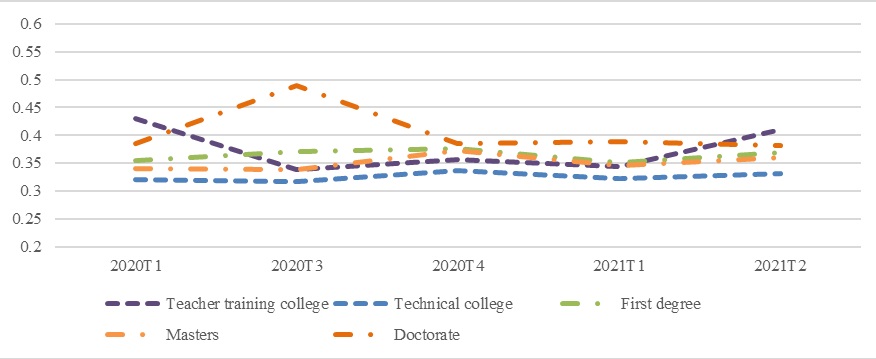
Figure 5 Inequality in the income of those interviewed with qualifications in higher technical and higher studies.
On the other hand, the gap decreased for those with teacher training, higher technical or master’s degrees; nevertheless, by the second quarter of 2021, the majority, excluding those with doctorates, returned to the GI they had had before the pandemic. An aspect to be emphasized is that workers with teacher training studies improved their GI significantly by up to approximately 9%, and a year later they had widened the gap in their incomes. This is probably due to the fact that education continued on line during the pandemic. It should be mentioned that over time those interviewed with qualifications in higher technical studies maintain a gap in wages that is more homogeneous and have a better GI than those with a different level of studies. This might be because of the characteristics of the work that is offered in Mexico.
The above is complemented by data from Monroy (2021), who points out that the greatest reduction in income was for the lowest-income population, causing an increase in income inequality.
Analysis of inequality for workers with higher level studies
Figure 6 below presents graphs differentiating the GI for employees with studies to the level of higher education according to their sex, and from these the income inequality during the period of lockdowns for those with first degrees or masters may be observed in comparison to that of those with a doctorate, and during the start of the lockdown the income gap of women in respect of the tendency that applied is seen to have been reduced, becoming favorable for women again in the first quarter of 2021. The results reflect the fact that the GI of the incomes of the EAP with higher studies is better for women. Which will be demonstrated subsequently with the Mincer regression equation, differentiated by sex.
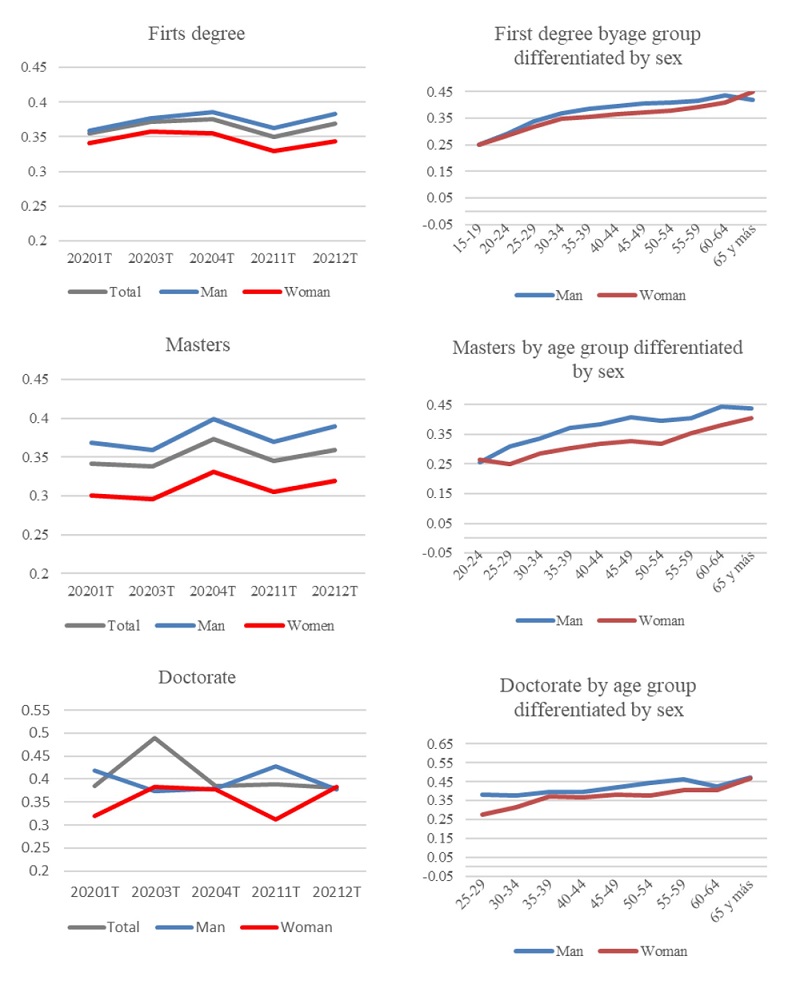
Figure 6 Inequality in the incomes of those interviewed with a qualification in higher level studies and for their age group differentiated by sex.
Next, Figure 7 provides a graph showing the GI for employees with a higher level qualification, differentiated by field of academic education.
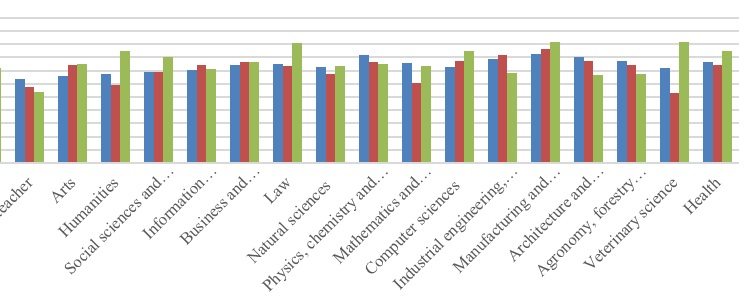
Figure 7 GI for employees with a higher-level qualification, differentiated by field of academic education.
It can be seen in the graph that the indices were lower for employees with a doctorate from Teaching Training studies and a master’s degree in Veterinary Science, Teacher Training, Humanities, Mathematics and Statistics.
Likewise, Figure 8 has graphs for employees with a level of higher studies, differentiated by academic education and by sex.
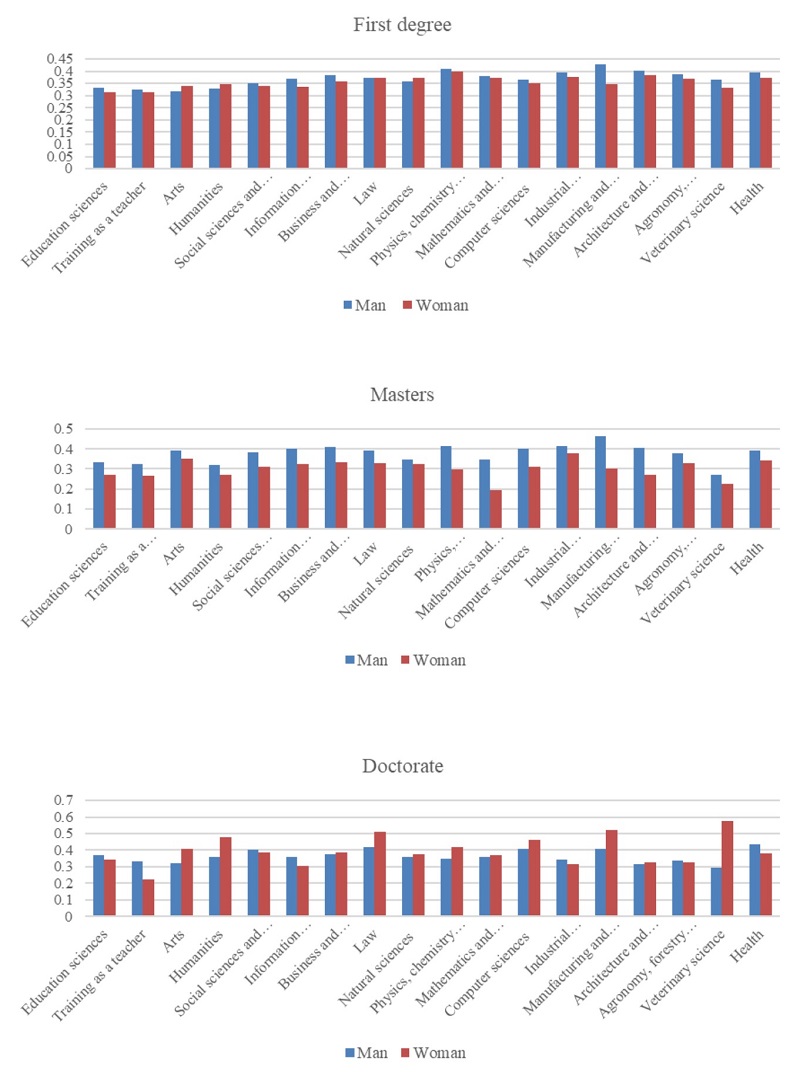
Figure 8 GI for employees with a higher level of studies, differentiated by field of academic education and by sex.
It can be seen from the graphs that for women with first degrees, the GI were lower than those for men in most areas, except for the arts, humanities, natural sciences and law.
As for those who had a master’s degree, it was demonstrated that for all areas of study, the lowest rates were for women, especially in services, mathematics and statistics, health, veterinary science and teacher training; finally, for those with doctorates, the areas where women had a smaller GI were: teacher training, information sciences, industrial engineering, agronomy, sciences of education, and health. These results show that for women investment in education favors employment.
With the previous results, it can be deduced that the relationship between the variation in income and the COVID-19 pandemic in professionals depended on a series of factors, such as job loss, reduction in working hours, change in work modalities, and changes in labor demand.
While some professionals were affected by job loss or reduced income, others were able to adapt to the new circumstances and, in some cases, even experienced improvements in their job and salary prospects.
The situation also evolved over time as economic recovery measures were implemented and vaccines were distributed to control the pandemic.
Analysis of income
To complete the analysis, after learning about the inequalities by areas of study, we go on to estimate the returns from education through the Mincer income equation, first the results from the income models estimated for the whole of the EAP, for men and for women, are resumed in Table 4. Subsequently, the results for each area of study are noted differentiated by sex.
Table 4 Results of the income models for the EAP, Men and Women.
| EAP | ||||||
| lnY | Coef. | Std. Err. | t | P>|t| | [95% Conf. Interval] | |
| Years of schooling | 0.044 | 0.000 | 391.38 | 0.000 | 0.044 | 0.044 |
| Exp | 0.020 | 0.000 | 264.67 | 0.000 | 0.020 | 0.020 |
| Exp2 | 0.004 | 0.000 | -271.52 | 0.000 | 0.000 | 0.000 |
| _cons | 7.866 | 0.002 | 4067.44 | 0.000 | 7.863 | 7.870 |
| Men | ||||||
| Years of schooling | 0.037 | 0.000 | 279.73 | 0.000 | 0.037 | 0.037 |
| Exp | 0.021 | 0.000 | 235.8 | 0.000 | 0.021 | 0.022 |
| Exp2 | 0.004 | 0.000 | -234.12 | 0.000 | 0.000 | 0.000 |
| _cons | 8.050 | 0.002 | 3604.15 | 0.000 | 8.046 | 8.055 |
| Women | ||||||
| Years of schooling | 0.061 | 0.000 | 327.75 | 0.000 | 0.061 | 0.061 |
| Exp | 0.022 | 0.000 | 175.1 | 0.000 | 0.022 | 0.022 |
| Exp2 | 0.004 | 0.000 | -189.48 | 0.000 | 0.000 | 0.000 |
| _cons | 7.486 | 0.003 | 2284.85 | 0.000 | 7.479 | 7.492 |
The results demonstrate, according to the value of the statistic t, that the parameters both for the EAP and for sex, are statistically significant at 5%. With regard to the coefficients, the rates for return on education were for the whole of the EAP and show that for every year of schooling income increases by 4.4%; for men it was by 3.7% whole for women it was by 6.1%, which shows that education pays better for women than for men.
Also, with regard to experience, the coefficients demonstrate that for every additional year of experience, people’s income increases by 2, 2.1 and 2.2% respectively and decreases equally to a rate of 0.04% as shown by the coefficient of experience squared.
The values of
Thus, with the aim of measuring the impact of income inequality on workers by area of professional training, Figure 9 presents the incomes for each profession when the values of
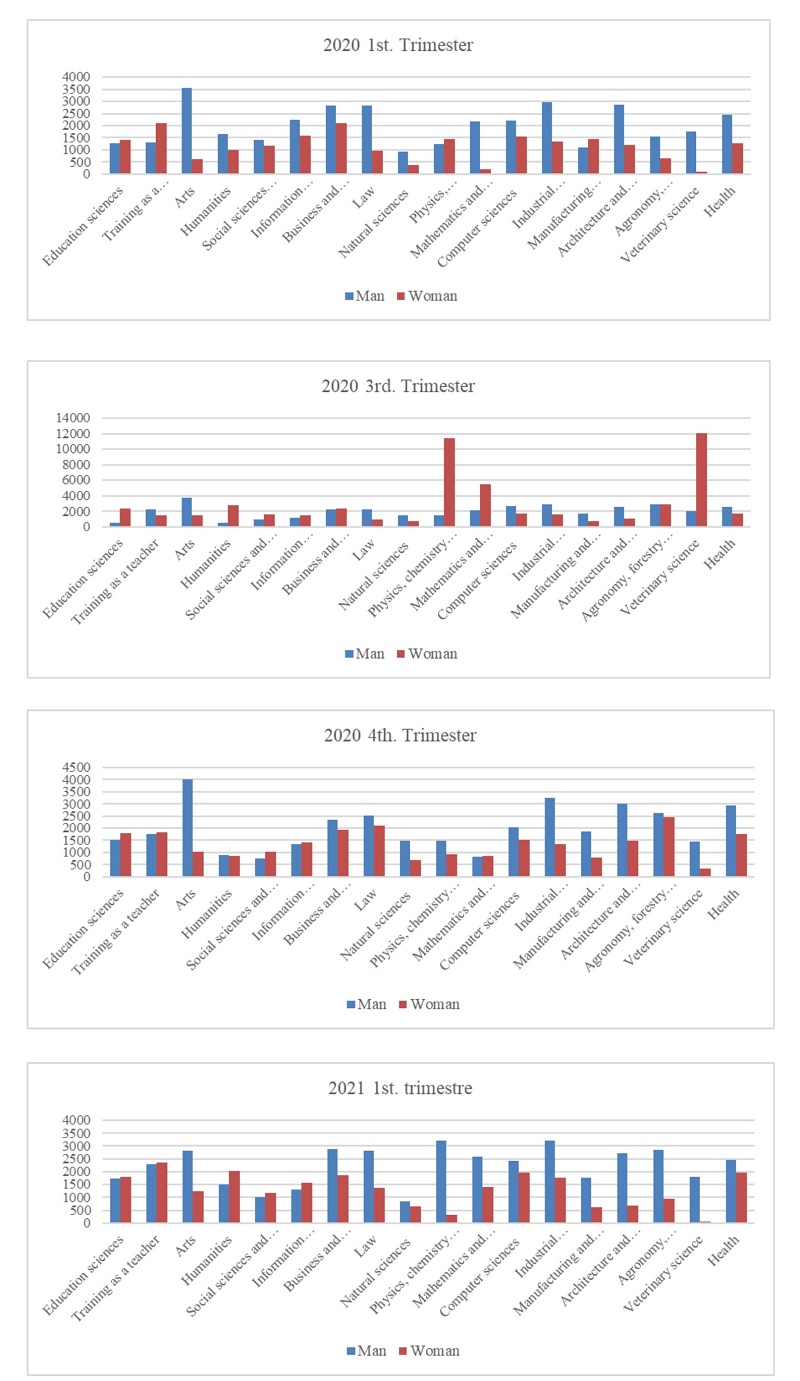
Figure 9 Incomes with first degree and zero years of experience for each area of study differentiated by sex.
We can state from the results that there are differences in the incomes of employees with an academic qualification, according to professional training or sex, and it is clear that the pandemic seems to have favored, in terms of income received, women in different professional areas, where previously as demonstrated in the graph for the first quarter of 2020 the income gap was in favor of men and those in the areas of the Humanities, Social Sciences and Behavioral Sciences, Information Sciences, Business and Administration, Mathematics, Statistics and Veterinary Science
The above agrees with Campos-Vázquez, et al. (2020) who comment that the structure of labor demand changed temporarily during the same period, there was greater demand for low-wage labor, occupations and workers with a low educational level in April, but from May to July the demand returned to the previous levels of the pandemic, teleworking did not increase in that period and the skills and personal characteristics sought did not change during the pandemic.
It is worth emphasizing that nearly a year after the start of the pandemic, as the graph for the first quarter of 2021 shows, incomes continued to have a favorable difference in the areas of the Humanities, Social and Behavioral Sciences, and Sciences of Information.
From the above, it is possible to deduce that the COVID-19 pandemic unequally affected the incomes of men and women, and in many cases, women faced additional economic challenges due to the intersection of gender inequalities and the economic consequences of the pandemic. These inequalities led to the creation of business policies and measures that promote gender equality in the workplace and address economic disparities that were exacerbated by the pandemic.
Discussion and Conclusions
In this study we have identified inequality for the EAP in terms of socio-demographic aspects, for those individuals with higher education qualifications, and it was possible to validate the first hypothesis by observing differences in occupations according to the age of the person interviewed, which demonstrated that with increased age, inequality increases.
In the same way, the greatest increase in the income gap, a difference of up to 8%, was observed between people with first degrees and those with a doctorate. Whereas qualifications from teacher training, higher technical and master’s courses had a reduction in the gap, returning to levels prior to the pandemic, after the first half of the year 2021, and it is thought that this situation may be related to the continuing digital education, in the case of teacher training courses. With regard to higher technical studies, the GI was more homogeneous and better than for other levels of education, which might be the consequence of the characteristics of work offered in Mexico. Furthermore, a better GI was found for women with higher education, showing a reduction in the income gap, but returning to normal in 2021.
The results of this analysis also showed inequality in occupation by areas of professional training, from the GI for the areas of Veterinary Science, Teacher Training, Humanities and Mathematics and Statistics, and it can also be noted that investment in education for women favors the occupation, as the higher the level of education, the smaller the inequality gap, which makes it possible to validate the second hypothesis and confirm that the level of education reached has an impact on the occupation held.
With regard to areas of professional training, the impact of inequality on the income of employees was measured, and it became clear that every additional year of schooling reflects a rate of return form investment in education of 4.4%, which, it should be mentioned, agrees with the results from the GI where women benefit from higher education, with a larger percentage than men, so there is an increase in income of up to 2.18%, and this makes it possible to validate the third hypothesis on the difference in income between male and female employees with higher education qualifications.
In the context of the pandemic, these differences in income were clearly in favor of women in particular professional areas as shown in the results, and agree with what we could see for the areas of teacher training, information sciences, industrial engineering, agronomy, sciences of education and health, where women reflected favorable conditions in terms of GI. This point concurs with Lobato (2020), who notes that incomes were reduced to a lesser extent in jobs considered essential and in reaction to the nature of the work and how possible it was for them to be adapted to digital forms of execution. With regard to the first variable, it may be concluded that the activities considered essential are feminized jobs. And for the second variable, as women are concentrated in jobs in the services sector, they generally adapted more than men did to working from home and a digitalizing of the work they did.
An important finding of this study is to verify that the gender wage gap, that is, the difference in income between men and women, persists before and after the epidemic and is due to a series of complex and multifaceted factors, such as: discrimination of gender, the distribution of social roles of men and women, women's role as family caregivers, etc. These factors continue to contribute to the persistence of the gender wage gap before, during and after the pandemic, although the pandemic itself has also accentuated some of these inequalities.
Another factor is that women choose fields of study and careers that historically pay less. This has exacerbated the pay gap, as traditionally female occupations tend to have lower wages, and this has continued during and after the pandemic.
Another important finding is the recognition of persistent salary differences between professional and non-professional before and after the COVID-19 pandemic. This is due to several factors that continue to affect the social wage structure, such as experience, job responsibilities, and market demand. Professionals' incomes often depend on investments in education and training (Beckers, 2009), as well as the specialized skills and experience they bring to the job.
Finally, with the present study it was determined that income inequality is a complex and persistent problem that requires continuous efforts from both governments and companies. Public employment policies after COVID-19 must adapt to the new labor and economic reality, focusing on employability, social protection, equal opportunities and the promotion of sustainable and quality employment. These policies must be flexible and willing to adapt as working and economic conditions evolve.











 nueva página del texto (beta)
nueva página del texto (beta)


